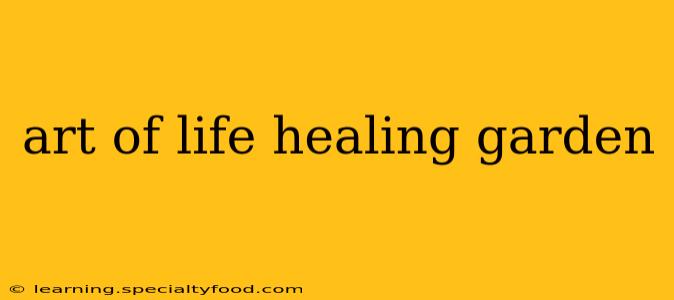For centuries, gardens have served as sanctuaries, offering solace, inspiration, and a profound connection to the natural world. But the concept of a "healing garden" goes beyond simple aesthetics; it’s about consciously designing a space that fosters physical, mental, and emotional well-being. This isn't just about pretty flowers; it's about creating an environment that nurtures the soul. This article explores the art of creating a life-healing garden, incorporating elements that promote tranquility, reflection, and rejuvenation.
What is a Healing Garden?
A healing garden, also sometimes referred to as a therapeutic garden, is a carefully planned outdoor space designed to enhance well-being. It utilizes the elements of nature – plants, water features, textures, and scents – to create a calming and restorative atmosphere. The specific design will vary depending on the needs and preferences of the individual or community it serves, but the core principle remains consistent: to provide a haven for healing and restoration.
What are the benefits of having a healing garden?
The benefits of a healing garden extend far beyond the visual appeal. Studies have shown that exposure to nature significantly reduces stress, lowers blood pressure, and improves mood. A well-designed healing garden can offer:
- Stress Reduction: The sights, sounds, and smells of nature have a proven calming effect, helping to alleviate stress and anxiety.
- Improved Mood: The vibrant colors and fragrances of flowers and plants can lift spirits and promote a sense of joy and well-being.
- Enhanced Focus and Concentration: The peaceful atmosphere of a garden can improve concentration and mental clarity.
- Physical Rehabilitation: For individuals recovering from illness or injury, a healing garden can provide a safe and supportive environment for gentle exercise and rehabilitation.
- Spiritual Connection: Many find a deeper sense of connection to themselves and the universe within the tranquil setting of a garden.
What plants are best for a healing garden?
Plant selection is crucial in a healing garden. Consider incorporating plants with calming properties, vibrant colors, and soothing fragrances. Some popular choices include:
- Lavender: Known for its calming scent and relaxing properties.
- Chamomile: Its delicate flowers and soothing aroma promote relaxation and sleep.
- Rosemary: Associated with improved memory and cognitive function.
- Mint: Its refreshing scent can invigorate the senses and uplift the mood.
- Rose: The beauty and fragrance of roses evoke feelings of love, peace, and tranquility.
Remember to choose plants that thrive in your specific climate and soil conditions.
How do I design a healing garden?
Designing a healing garden requires thoughtful consideration of several factors:
- Space and Layout: Consider the size and shape of your available space and how you want to use it.
- Sensory Elements: Incorporate elements that stimulate the senses, such as fragrant plants, soothing water features, and textured pathways.
- Color Palette: Use a color palette that evokes feelings of calm and serenity.
- Seating and Resting Areas: Provide comfortable seating areas where you can relax and enjoy the garden.
- Accessibility: Ensure the garden is accessible to all users, regardless of physical limitations.
How can I incorporate water features in my healing garden?
Water features are a powerful addition to a healing garden. The gentle sound of flowing water has a deeply relaxing effect, creating a tranquil and meditative atmosphere. Consider a small fountain, a pond with aquatic plants, or even a simple birdbath.
What are some examples of healing garden designs?
Healing gardens can take many forms, from small patio gardens to expansive landscapes. Some examples include:
- Sensory Gardens: Designed to stimulate the five senses through fragrant plants, textured surfaces, and visual displays.
- Meditation Gardens: Quiet and secluded spaces designed for reflection and contemplation.
- Memorial Gardens: Gardens created to honor the memory of loved ones.
- Rehabilitation Gardens: Gardens designed to support physical and emotional recovery.
How much does it cost to create a healing garden?
The cost of creating a healing garden varies significantly depending on the size, complexity, and materials used. A small, simple garden can be created for a relatively modest cost, while a larger, more elaborate design may require a substantial investment.
By carefully considering the elements discussed above, you can create a truly healing and restorative space—a haven for tranquility and rejuvenation that will enrich your life in countless ways. The art of creating a life-healing garden is a journey of self-discovery and connection with the natural world, yielding lasting benefits for your mind, body, and spirit.
